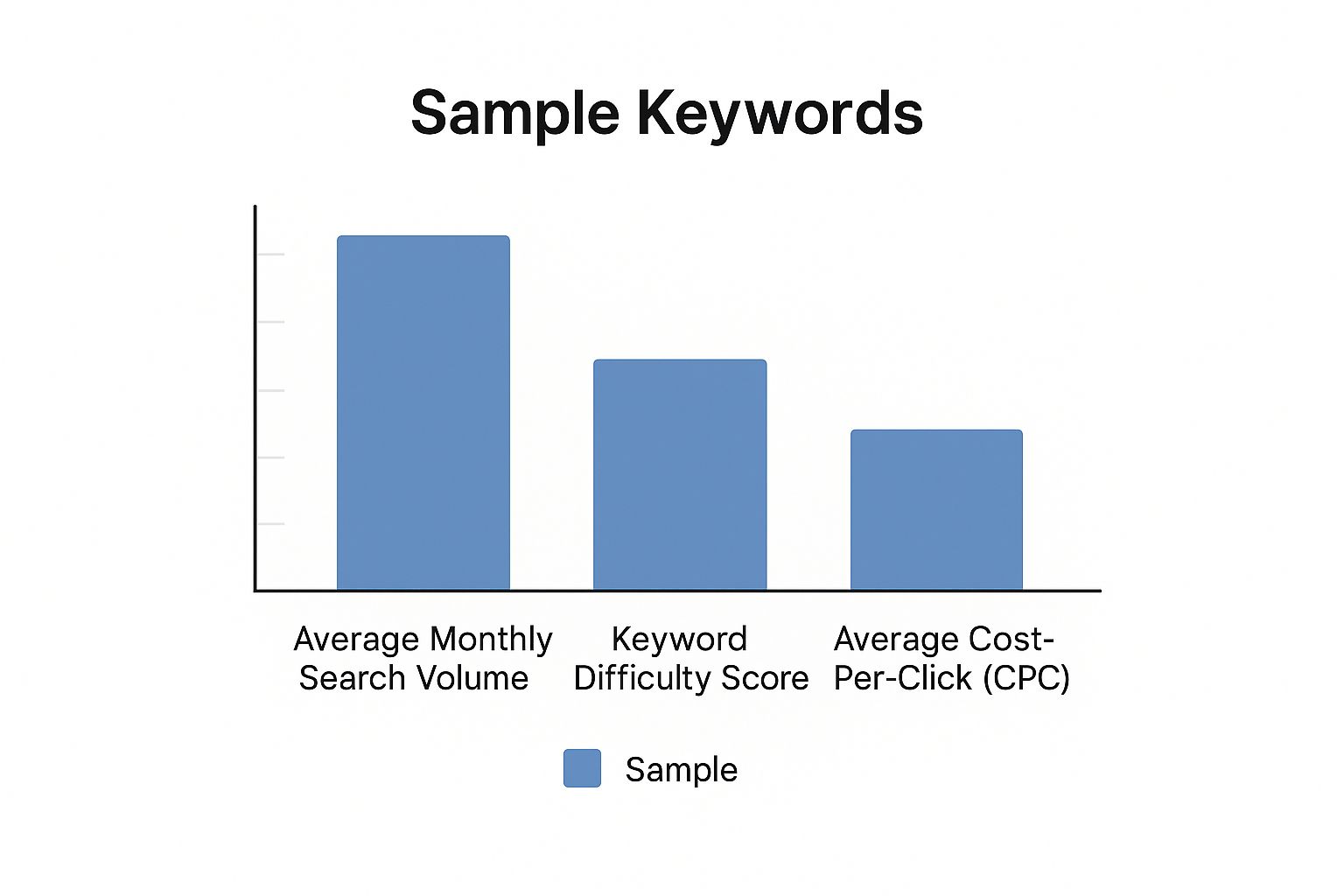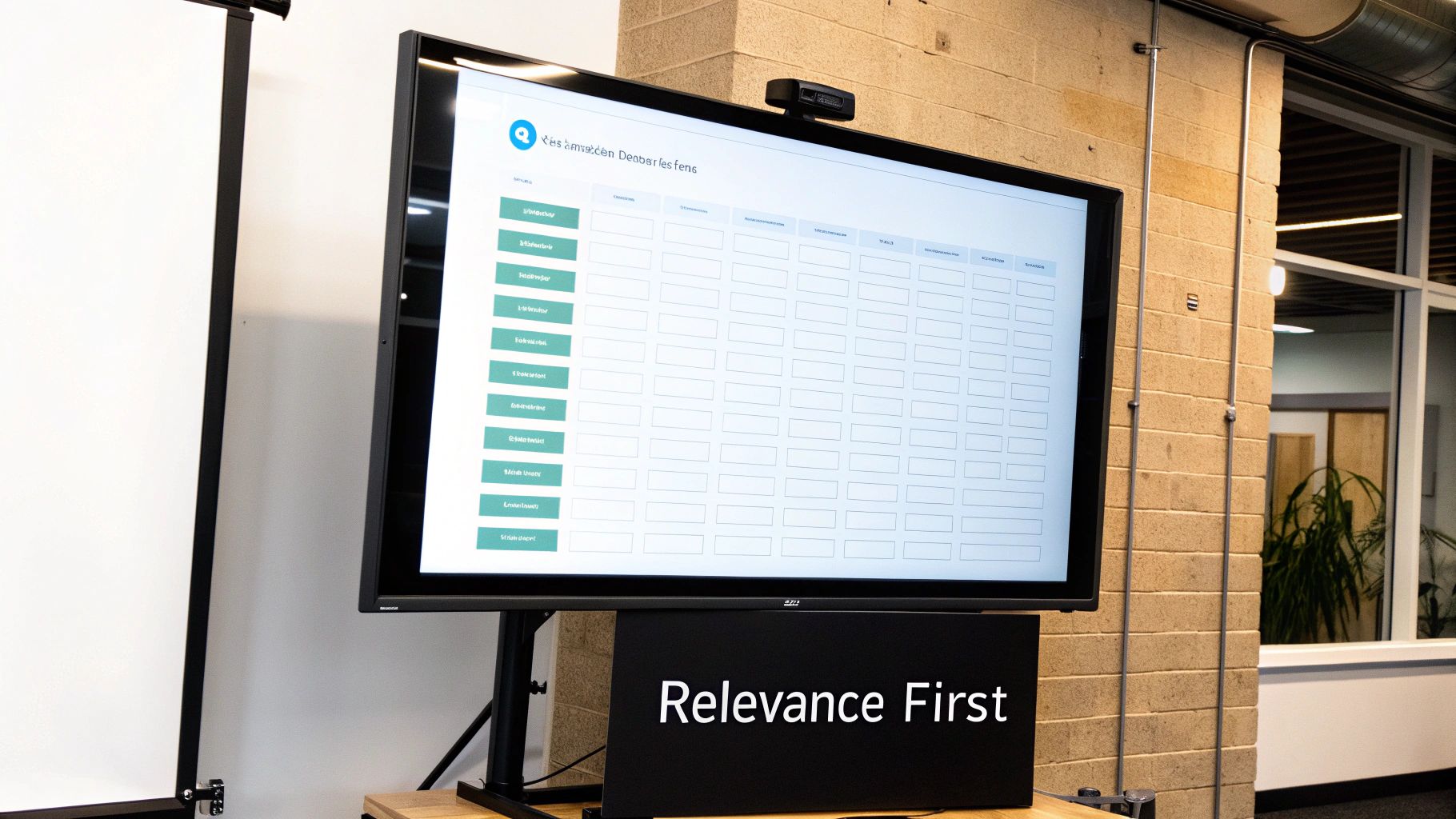August 26, 2025
How to Choose Keywords for SEO in 2024


Finding the right keywords isn't about pulling random phrases out of a hat. It's a strategic process that starts with identifying the core, foundational terms for your business and then branching out to the specific, niche phrases your customers are actually typing into Google. The real magic happens when you strike a balance between broad topics and those super-specific, long-tail keywords that scream "I'm ready to buy."
Start Your Keyword Search By Planting "Seed" Terms
Before you dive headfirst into spreadsheets and fancy keyword tools, every great keyword strategy starts with a simple, old-school brainstorming session. This is where you nail down your "seed" keywords.
Think of these as the main pillars of your business—the big-picture terms that define what you do. This first step isn't about search volume or competition; it's about getting real. How would an actual person describe the problem you solve? What words would they use to find you?
Brainstorming Your Core Business Topics
Your mission here is to create a list of broad topics that tie directly back to what you sell. Don't overthink it. Just get the ideas down on paper (or a doc, whatever works).
If we were doing this for a tool like Keywordme, our initial list of core concepts might look something like this:
- Google Ads optimization
- PPC keyword management
- Negative keyword lists
- Ad campaign performance
See? These aren't the exact phrases we'll bid on. They're the starting blocks. They ensure that every other keyword we find later is actually relevant to our business goals. This simple step keeps you from chasing vanity keywords that drive traffic but never turn into paying customers.
The best keyword strategies are built from the ground up. Start by nailing down the 5-10 core topics that truly define your business's value. These will be your compass for everything that comes next.
Get Inside Your Customer's Head
Once you have your seed topics, it’s time to put on your customer hat. If your core topic is "Google Ads optimization," what specific problems or questions is someone wrestling with?
They're probably searching for things like "how to improve Google Ads ROI" or "common Google Ads mistakes." Maybe even "why are my Google Ads so expensive?"
This little exercise is a game-changer. It shifts your focus from your industry jargon to the actual language your customers use. Nailing this part is what separates a keyword list that looks good from one that actually connects with real people and drives results. It lays the groundwork for a much smarter, more effective strategy down the road.
The Secret to High-Intent Traffic: Go for Long-Tail Keywords
Everyone wants to rank for those big, flashy keywords with massive search volumes. It’s tempting, I get it. But honestly, those terms are often a fool's errand—they're incredibly competitive and the people searching for them are usually just kicking tires, not ready to buy.
The real magic, especially in Google Ads, happens in the long-tail.
Long-tail keywords are those longer, more specific phrases people type into Google when they're much closer to making a purchase. Think about the difference in mindset here. Someone searching for "shoes" is just browsing. But someone searching for "red running shoes for women size 8"—they know exactly what they want. They’ve probably got their credit card handy.
That specificity is your golden ticket. While your competitors are burning cash fighting over broad terms, you can swoop in and grab highly motivated visitors who are far more likely to convert.
Why Being Specific Is a Superpower
When you target these super-detailed phrases, you're not just throwing content at a wall and hoping it sticks. You're creating a direct line to someone's specific need or problem. Instead of shouting into a crowded room, you're having a one-on-one conversation with a small, highly engaged audience.
This approach does more than just boost your conversion rates; it cements your reputation as the go-to expert in a specific niche.
Let's look at a real-world example:
- Broad Keyword: "CRM software" (Good luck with that! The volume is huge, but so is the competition from major players.)
- Long-Tail Keyword: "CRM software for small real estate agencies" (The volume is way lower, but every single person searching this is a potential perfect customer.)
To see how these two types of keywords stack up, here’s a quick breakdown.
Short-Tail vs. Long-Tail Keywords
As you can see, long-tail keywords offer a much more efficient path to getting actual customers, not just clicks.
This image really drives the point home, showing how metrics like search volume, competition, and cost-per-click usually play out.

The sweet spot is often right there in the long-tail—lower volume, sure, but also lower difficulty and cost. That means a better return on your investment.
How to Find These Hidden Keyword Gems
So, how do you actually find these valuable long-tail phrases? It takes a bit of detective work. You have to step into your customer's shoes and think like they do. What questions are they asking when they feel stuck or need a solution?
A fantastic starting point is to lurk in the online communities where your customers actually spend their time. Forums like Reddit, Quora, and niche industry groups are absolute goldmines. You’ll find the exact language people use to talk about their problems.
Don't forget to look in your own backyard, too. What are the most common questions your customer service team gets? Every one of those questions is a potential long-tail keyword that real people are searching for. By mining these sources, you'll uncover incredibly valuable, low-competition phrases your competitors have almost certainly missed.
If you want to dig even deeper, we have a whole guide on how to find niche keywords for your campaigns.
The data absolutely supports this strategy. An incredible 94.74% of all keywords get 10 or fewer searches per month. That tells you the vast majority of search queries are ultra-specific. Even at the high end, over 29% of keywords with more than 10,000 monthly searches are made up of three or more words, proving that even popular searches can be long-tail. You can see more SEO stats on Digitalsilk to get the full picture.
Figuring Out What Your Audience Really Wants

Here’s a classic mistake I see all the time: picking keywords based purely on how many people are searching for them. It’s an old-school approach that’s guaranteed to burn through your budget and attract a ton of traffic that never actually buys anything.
To get real results, you have to shift your thinking. Stop obsessing over what people are typing into Google and start digging into why they’re typing it. That "why" is what we call search intent, and it’s the secret sauce to a killer keyword strategy.
Getting this right is everything. You have to play detective, read the clues in the search query, and align your content with what the searcher is actually trying to accomplish.
The Four Flavors of Search Intent
Every single search query can be boiled down to one of four core motivations. Once you get a handle on these, you can start creating content that actually hits the mark.
Informational Intent: These folks are looking for answers. Their searches are packed with questions like "how to," "what is," or "why does." They want guides, tutorials, and straight-up information.
Navigational Intent: This is the simplest one. The person already knows where they want to go and is just using Google to get there faster. Think "Keywordme login" or "YouTube."
Commercial Intent: These searchers are in the consideration phase. They have a problem and know they need to buy something to solve it, but they're still weighing their options. They're looking for things like "best CRM for small business" or "Keywordme vs competitor."
Transactional Intent: This is it—the money-making moment. The user has their credit card in hand and is ready to buy. Their searches are direct and action-focused, like "buy Nike running shoes" or "Keywordme free trial."
Your goal isn't just to rank for a keyword; it's to serve the right content to the right user at the right time. Pushing a product page on someone with informational intent is like trying to sell a new car to someone who just stopped to ask for directions. It’s just not going to work.
Let the SERP Be Your Cheat Sheet
So, how do you nail down the intent for a specific keyword? It's easier than you think. Just Google it.
Seriously. The Search Engine Results Page (SERP) is a goldmine of information, showing you exactly what Google’s algorithm has determined users want to see for that query.
Toss your target keyword into the search bar and take a hard look at what pops up.
- Seeing a wall of blog posts and "how-to" articles? That’s a massive clue for informational intent.
- Is the page full of product pages from e-commerce sites? You’re looking at transactional intent.
- Finding lots of review sites and top-10 lists? That’s a dead giveaway for commercial intent.
By taking a minute to analyze the SERP before you even think about creating content, you eliminate all the guesswork. You're essentially using Google's own data to confirm your strategy. This one small step is what separates the pros from the amateurs and turns a basic keyword list into a real engine for business growth.
So, Can You Actually Rank for That Keyword? Let's Find Out.
Alright, you've got a nice list of potential keywords. Great start. But that's only half the equation. The real question, the one that separates successful campaigns from money pits, is this: "Can I actually win this fight?"
This is where you have to put on your detective hat and do some real competitive analysis.
It's so tempting to just glance at the "keyword difficulty" score a tool spits out and move on. But that number is just a signpost, not the whole map. To really understand what you're up against, you’ve got to get your hands dirty and look at the search results yourself. Who’s really showing up on page one for the terms you want?
Don't Just Trust the Difficulty Score
Think of a keyword difficulty score as an algorithm's best guess. It’s a helpful starting point, but your own eyes will give you the ground truth.
Pop open an incognito window in your browser (so your personal search history doesn't skew the results) and search for your keyword. Now, take a good, hard look at the top 10 results.
Are you staring down a list of massive, household-name brands with seemingly infinite marketing budgets? Or is the page sprinkled with smaller blogs, niche sites, and businesses that look a lot more like yours? Seeing a few smaller players in the mix is a fantastic sign. It tells you that you have a real fighting chance.
Your goal is to find that sweet spot: keywords with enough search volume to be worthwhile, but with a level of competition you can realistically beat. This simple manual check can save you from wasting months chasing a keyword that was never in your league to begin with.
How Good Is the Content You're Up Against?
Next up, it’s time to click on those top-ranking pages. Don't just skim them—I mean really read them. How solid is their content? Is it a comprehensive, beautifully written guide, or a thin, 500-word blog post from 2018 that hasn't been touched since?
You're looking for weaknesses, for cracks in their armor that you can exploit.
- Is the information old news? Are they citing outdated stats or talking about trends that have long since passed?
- Is the user experience a nightmare? Does the page take forever to load? Is it plastered with annoying pop-ups and ads?
- Are there obvious gaps? Did they completely miss a crucial subtopic or fail to answer the searcher's question in full?
If you start seeing a bunch of mediocre, outdated, or incomplete content ranking, that’s a massive green light. It means you can create something significantly better—more detailed, more helpful, and more current—and potentially leapfrog them in the rankings. To get a better handle on this, you can take a deeper dive into understanding keyword difficulty metrics.
The goal isn't just to be as good as what's ranking. The goal is to create something that is 10x better than anything else on that first page. You have to ask yourself, "If I were searching for this, would my article be the absolute best, most complete answer I could find?"
This hands-on approach is so important because the fight for visibility is intense. Think about this: only about 1% of webpages get more than 11 clicks per month, and an incredible 94% get zero traffic from Google.
The top spot on Google gets an average click-through rate of 28.5%. That plummets to just 15.7% for the second position. These numbers from Meetanshi show just how critical it is to aim high, because even small gains in ranking can mean a huge jump in traffic.
Using AI to Modernize Your Keyword Research

Let’s be honest, keyword research used to be a total slog. I remember spending days, if not weeks, buried in spreadsheets, trying to manually pull out a handful of decent terms. It was a grind, and frankly, not the best use of anyone's time.
Thankfully, that old-school approach is going extinct, and AI is leading the charge.
This isn't about handing your strategy over to a robot. It’s about arming yourself with insights you simply can’t find on your own. Think of AI as your super-powered assistant, one that spots patterns and opportunities in seconds, freeing you up to focus on the big picture.
The timing couldn't be better. With the AI market expected to balloon to $190 billion by 2025, the tools we have at our fingertips are getting ridiculously powerful. They can analyze user intent, predict search trends, and find content gaps with a precision that was unimaginable just a few years ago.
Uncovering Deeper Connections with Semantic Search
One of the biggest breakthroughs AI brings to the table is its knack for understanding the meaning behind a search query. It goes way beyond just matching exact keywords.
AI-powered tools can map out semantically related keywords—all the concepts, subtopics, and related questions that orbit your main term. This is how you build true topical authority.
For instance, if you're targeting "PPC campaign," an AI tool won't just give you variations of that phrase. It’ll suggest ideas like:
- "ad group best practices"
- "negative keyword strategy"
- "improving quality score"
Weaving these related ideas into your content and ad campaigns tells Google that you're an expert on the entire subject, not just a single keyword.
From Manual Lists to Smart Clusters
Here’s where you’ll really see the time savings pile up: AI-powered keyword clustering. Forget spending hours trying to manually group thousands of keywords into logical ad groups or content hubs. AI does it for you, instantly.
It groups terms together based on their shared intent and semantic connections, giving you a clear roadmap for your content or campaign structure.
This is an absolute game-changer for content planning. AI clustering hands you a ready-made content structure, showing you exactly how to build out topic clusters that cover every angle of a subject. Your strategy just got smarter and a whole lot more effective.
Using tools that provide AI prompts for keyword research can make this even easier. A platform like Keywordme is built on this very idea. It helps you move past flat keyword lists and build a cohesive strategy that mirrors how real people actually search for things.
If you're ready to speed up your entire workflow, our guide on how to https://www.keywordme.io/blog/automate-keyword-research is the perfect next step. You'll learn how to plan faster and create content that truly hits the mark.
Answering Your Lingering Keyword Questions
Even with a solid plan, a few nagging questions always seem to pop up during keyword research. It happens to everyone. Let's dig into some of the most common ones I hear and get you some straight answers. Nailing these details can be the difference between a so-so campaign and a truly successful one.
How Many Keywords Should I Really Target Per Page?
This is the classic question, and the answer has definitely shifted. Years ago, the playbook said to target one primary keyword for each page. That thinking is officially outdated. Today, it’s all about targeting a topic cluster.
A single, well-built page can easily rank for dozens, sometimes even hundreds, of related keywords and long-tail phrases. Your mission should be to create the absolute best, most thorough resource on one specific topic. When you do that, you'll naturally start pulling in traffic from a whole bunch of related search terms.
Forget the old "one keyword, one page" rule. Think bigger. Focus on covering a single topic so well that your page becomes the go-to answer. You'll end up ranking for all sorts of related searches without even trying.
Should I Still Care About Keyword Density?
Honestly? No, not really.
Keyword density—that old metric of how many times a keyword appears on a page—is a relic from a simpler time in SEO. Obsessing over hitting a specific percentage, like 1-2%, is a fast track to writing clunky, unnatural content that nobody wants to read.
Google and other search engines are way smarter now. They get synonyms, context, and the relationship between concepts. Just write for your audience. Focus on creating a genuinely helpful, easy-to-read article. If you're truly covering the topic, the important keywords will show up organically.
How Often Should I Revisit My Keyword Strategy?
Your keyword list isn't something you can just set and forget. The way people search is always evolving, and new trends pop up all the time. As a general rule, plan on doing a major review and refresh of your keyword strategy at least once or twice a year.
That said, you need to be watching your performance way more often. Check in on your rankings and traffic data monthly. If you notice a page starting to slip or traffic dipping, that's your signal to jump in and re-evaluate its content and keyword focus right away. For a great breakdown of the core ideas behind this process, you can learn more about what keyword research in SEO entails.
What If a Keyword Has Super Low Search Volume?
Don't be so quick to toss out a keyword just because a tool says it has low monthly search volume (MSV). Those low-volume terms can be hidden gems.
Here's why:
- Sky-High Intent: A really specific, long-tail keyword often comes from someone who knows exactly what they want and is ready to buy.
- Way Less Competition: While everyone else fights over the big-volume keywords, you can quietly own the niche terms and win easy traffic.
- The Data is Just an Estimate: Remember, keyword tools are not perfect. A term showing 10 searches a month could easily be getting more, especially if it's a new or niche trend.
Targeting a few of these low-competition, high-intent keywords can often bring in more valuable traffic than spending all your budget chasing a single, highly competitive term.
Ready to stop juggling spreadsheets and start building smarter, more effective Google Ads campaigns? Keywordme brings all your essential keyword tasks into one intuitive platform. Find high-converting keywords, clean up wasted ad spend, and automate your optimization workflow in a fraction of the time.


.svg)